Oceans cover more than 70 percent of the Earth’s surface and make the Earth appear blue from space. Do you know that our vast and blue oceans is a great treasure? Let’s find out about this treasure!
The similarity and difference between sea and ocean?
The oceans on Earth are connected to make up a body of water that cover more than 70 percent of the Earth’s surface. There are five oceans: the Pacific, the Atlantic, the Indian, Southern, and Arctic Ocean.
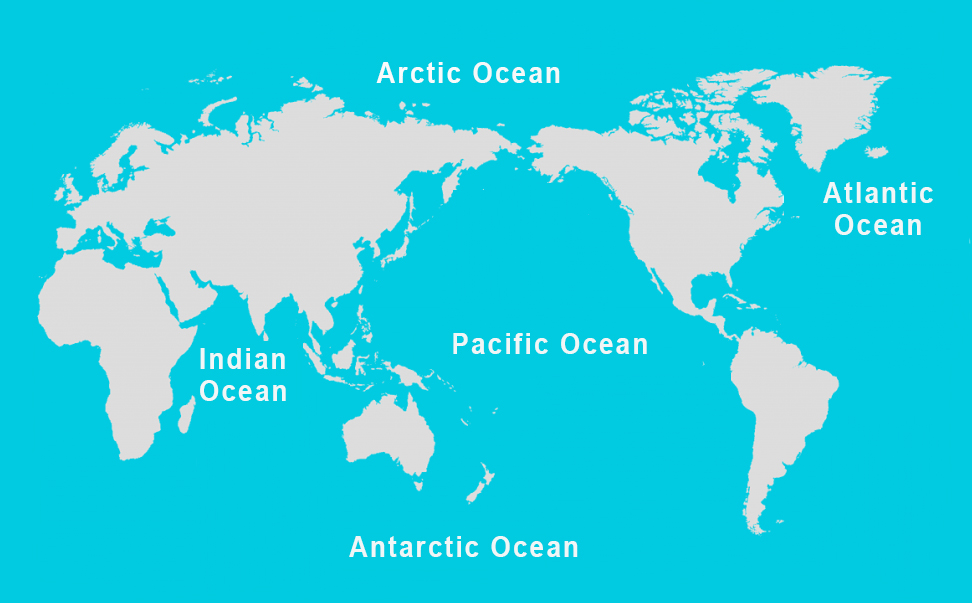
Sea is a small part of ocean, and is partially enclosed by land. There are about more than fifty seas around the worlds. Some distinctive seas are: the Mediterranean Sea, the Caribbean Sea, the South China Sea, the Okhotsk Sea, The Gulf of Mexico.
Except for the aforementioned differences, sea and ocean are quite similar. Therefore, we often use “sea” and “ocean” interchangeably.
Similar to AQI (Air Quality Index) or WQI (Water Quality Index), ocean has its own indicator called Ocean Health Index (OHI).
Ocean Health Index (OHI) is an index to measure ocean quality, which is based on 10 goals about ecological, social, and economic aspects of the ocean, including: food provision, artisanal fishing opportunities, natural products, coastal protection, carbon storage, coastal livelihoods and economies, tourism and recreation, sense of place, clean waters, and biodiversity. OHI is an effective tool for countries to monitor ocean’s ecological health. Vietnam is ranked 150 out of 221 Exclusive Economic Zones (EEZ), which is a relatively low rank compared to other countries. The 10 aforementioned goals should be the basis for Vietnam’s ocean protection measures and sustainable development in the future. [1]
Why is seawater salty?
If you have ever been to the beach, you will know that seawater is very salty. You must have noticed that seawater is salty because it contains salt. If we extracted all the salt from seawater and spread it over the surface of the Earth, we might have a salt layer 150 feet thick, similar to the height of a 40-story building. So where does the salt in the ocean come from?

Photo: Einsteinium03 Youtube
Through the processes of soil erosion along with rainwater and streams, very old rocks in the Earth's crust (also called “igneous rock”) are broken down into small fragments, forming salt. This salt is released into the ocean and the sea. This process began millions of years ago, long before man appeared.
You probably wonder why seawater is salty, even though freshwater from rivers, streams, etc. pours into oceans every day. The saltiness of the sea comes from natural processes; the volume of freshwater from rivers and streams is not enough to reduce the salinity of the sea. If the salinity of fresh water is 0%, salinity of seawater is about 3.5%
Why is the ocean blue?
When we pour seawater into a glass, we find out that seawater is transparent. But when we look at the sea from far away, the sea is blue. To understand why this happens, you first need to know that sunlight has a wide spectrum: red, orange, yellow, green, blue, indigo and violet. This spectrum is often referred to as "rainbow colors". These seven colors can be divided into two groups: hot (red, orange, yellow) and cold (green, blue, indigo, violet).
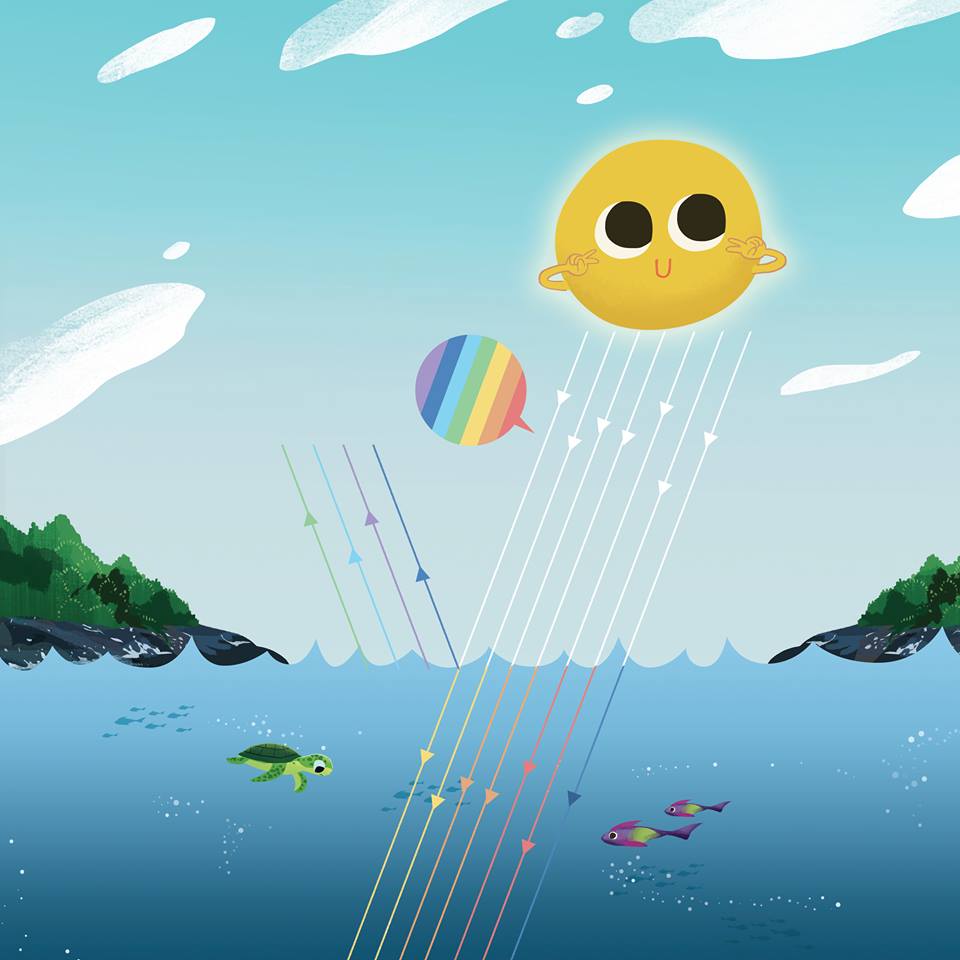
When sunlights enter seawater, hot-colored rays can penetrate through obstacles, so these rays can constantly be absorbed by seawater and marine organisms. Meanwhile, cold-colored rays are partially absorbed by seawater and certain cold-colored organisms such as algae. Most of these rays are blocked by seawater, scatter around, orget returned. In deep seawater, the more cold-colored light is scattered, the darker the color of the seawater becomes.
There are also seas with strange colors. The Red Sea is red because it has a lot of red algae in it. Another is the Black Sea: it looks almost black. The water there contains a high concentration of hydrogen sulphide. But don’t worry, your skin won’t turn pink or gray if you swim there!
Why do water temperature vary in different seas?
The largest heat source that seawater receives is from the sun. However, due to uneven distribution of solar radiation in regions with different temperature, the temperatures in different seas or oceans in the world are not the same. For example, in the South China Sea, the sea in the north has a temperature ranging from 22 to 24 degrees Celsius, while the sea in the south is about 25 to 27 degrees Celsius. So, when swimming in the south, you may feel the sea water is a little warmer![2]
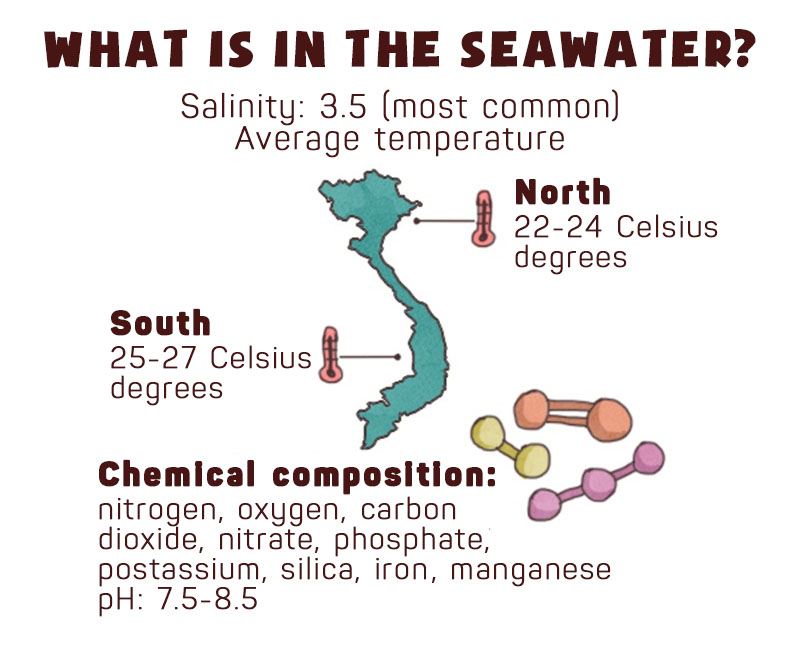
The sea is in constant movement!
At the beach, we can see that the sea never stops moving. Some of the movements can be easily seen with naked eye, but there are also some movements that only take place in very deep layers of the ocean.
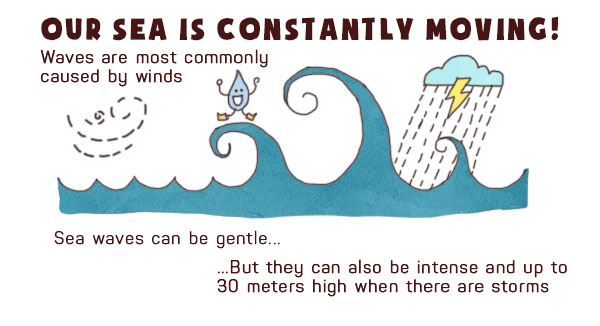
Waves: Sea waves are formed primarily from wind. It occurs where seawater in layers near surface moves. Waves may travel thousands of kilometers before reaching the shore. Waves can sometimes be gentle, but they can also be strong, violent and tens of meters high in the event of a storm. Factors such as wind speed and duration of the wind helps determine the size, shape and frequency of ocean waves.[3]
Tsunamis: Tsunamis are formed by great disturbance in the ocean, maybe an earthquake, landslide or volcanic eruption. Tsunamis arelargely unpredictable, so when an earthquake is about to happen, a tsunami warning isalso broadcasted. The destruction of a tsunami can be devastating. A tsunami can travel at the speed of 800-965 km/h offshore, same as the speed of a jet plane! When approaching shallow water near the shore, it slows down to only about 50 km/hour. However, it could still be as high as 15 to 30 meters, capable of easily and quickly engulfing and destroying a coastal city. In 2011, a 15-meter high tsunami appeared in Fukushima, Japan, which killed more than 100,000 people, leaving more than 60,000 people displaced and causing severe leakages in the Fukushima nuclear power plant.[4]

Tides: Tides are the rise and fall of seawater in a given cycle. Tides are formed mostly by the gravity of the Moon and partially by the Sun. Coastal residents experience two types of tides: diurnal tide and semi-diurnal tide. Diurnal tide consists of a high tide and a low tide each day. This is popular in the northern part of Vietnam and Thanh Hoa. Semi-diurnal tide consists of two high tides and two low tides each day. This is more common near the equator, for example in Thuan An Beach (Hue). In addition, the Highest Astronomical Tide is the highest tide on moonless nights or full moon; Lowest Astronomical Tide is when the tide falls to the lowest on half-moon nights.

Currents: Currents are movements of a large body of water in a certain direction. Currents may flow temporarily in one direction and then switch direction, or may flow permanently in one direction. We can see currents near the water’s surface, but there are also currents that only appear in deep waters. Deep ocean currents are called rivers in the ocean because they flow in a fixed direction. There are two types of deep ocean currents: warm currents and cold currents. Warm currents from the equator flow to the poles, making coastal climate humid and rainy. By contrast, cold currents flow from the two poles to the equator, making the coasts dry and less rainy.

Rip currents: Rip currents are strong currents flowing in a direction perpendicular to the shore. Despite their small size (3 to 30 meters high, 100-150 meters long), the speed of the rip currents can reach a maximum of 2 meters per second.[5] At this speed, the rip currents can sweep away people to about 120 meters away in just one minute! When that happens, no one could swim against the current back to the shore. To deal with rip currents, it is advised to keep calm, avoid swimming against the current. Instead, we should swim parallel to the shore (perpendicular to the current). [6]
Life under the sea
Ocean is the home for millions of marine life. Marine organisms consist of diverse species of animals, plants, bacteria, and viruses living in the ocean world, ranging from microscopic species such as microalgae to the largest animals in the world such as the blue whale, locating in places from brackish waters, estuaries, and coastlines to deep seabed.
Essentially, marine life defines the nature of our planet. Marine organisms produce the oxygen that we breathe. Coastals are formed and protected by a network of marine life, and marine organisms even help shape new coastal landscapes.
Most forms of living organisms on Earth evolved from the sea. The ocean provides us with about 99% of the living environment on Earth. The first vertebrates appeared in the form of some fish species. Some of these developed into amphibians, which live partly in water and partly on land. Some grew into mammals that live on land but then also came back to water, such as seals, dolphins, and whales. Underwater plants, like algae, also grow, acting as the basis for some marine ecosystems. Phytoplankton are key productive organisms in the ocean food chain. A total of 230,000 marine species have been identified, including more than 16,000 species of fish. An estimated 2 million marine species have not been recorded. [7]
The habitats of these species range from surface waters to deepest ocean gullies, including coral reefs, algae forests, seagrass beds, tidal pools, mudflats, sandbanks, cascades of rock at the bottom of the sea.
In Vietnam, our sea contains about 20 different ecosystems, such as coastal estuarine ecosystems, mudflats, mangroves, coral reefs, etc. According to statistics, there are about 12,000 marine species in Vietnam. Among them, there are about 2000 species of fish, 6000 species of benthic animals, 2500 species of molluscs, more than 600 species of algae, 14 species of seagrass. Besides, the sea of Vietnam also has diverse animals such as sea shrimp, sea turtles, sea snakes, waterfowls. [8]
Do you know?
- The Pacific Ocean is the largest ocean in the world and accounts for 30% of the Earth's surface.
- The Dead Sea is known as the world's most salty sea with a salinity of up to 30%, which is 7-8 times the average salinity in other places. It is because of such amazing salinity, you do not need to know how to swim but can still float in the water!
- Confluence, the meeting of two or more bodies of water, can create the appearance of split water surface where water surface is divided into two different colors, usually occurring at river mouths where the river water flows to the sea or at the intersection of two oceans. The difference in the salinity of the different kinds of water is the reason for this phenomenon.
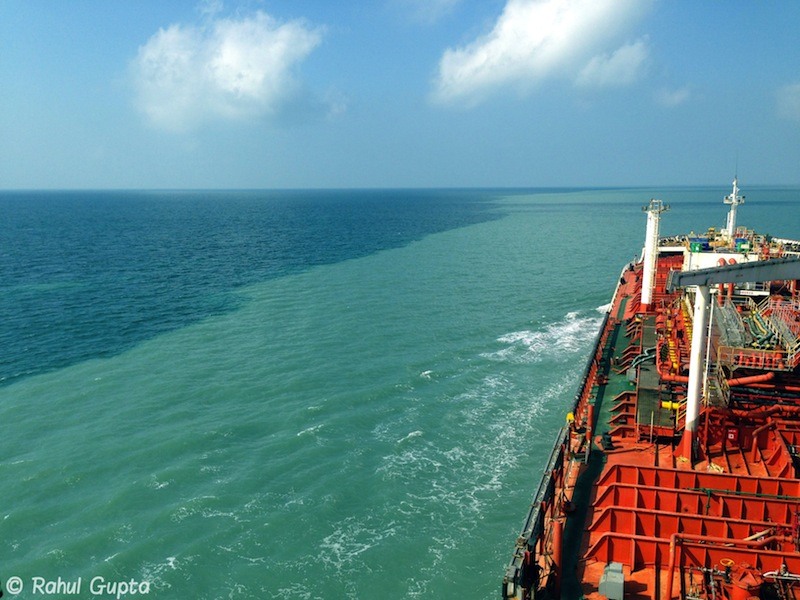
Water surface is divided into two different colors. Photo: Rahul Gupta, Marine Insight.
- Red tide, or algal blooms, is the phenomenon where algae overpopulate and are concentrated in a high density of water. The cause of this phenomenon is increased nutrient content in the water, possibly due to contaminated waste from the shore. This process generates toxins, reduces dissolved oxygen, and can kill fish, mammals living in the sea.
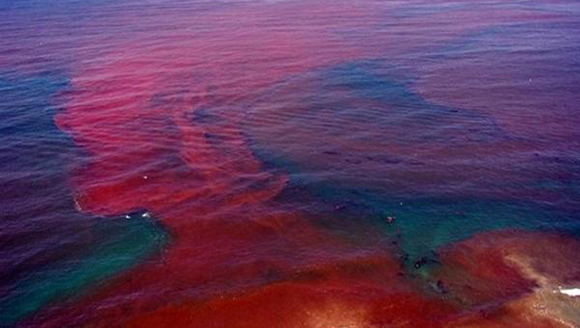
Red Tide. Photo: Space Coast Daily, from Wall Street OTC Image
- The Maldives is famous for its luminescent waves. This is due to the presence of a myriad of plankton, single-celled organisms, or crustaceans with ability to radiate luminescence in order to escape the attention of predators.
- In Vietnam, the ritual of worshiping the Ca Ong, such as whales, dolphins, or large fishes is a custom or tradition of coastal residents of the central and southern regions, from Thanh Hoa southward. According to the fishermen, Ca Ong, or the “king fish,” is the embodiment of the Nam Hai God, or literally the “god of the southern sea.” People often worship Ca Ong and other gods who help and bestow blessings on the fishermen.
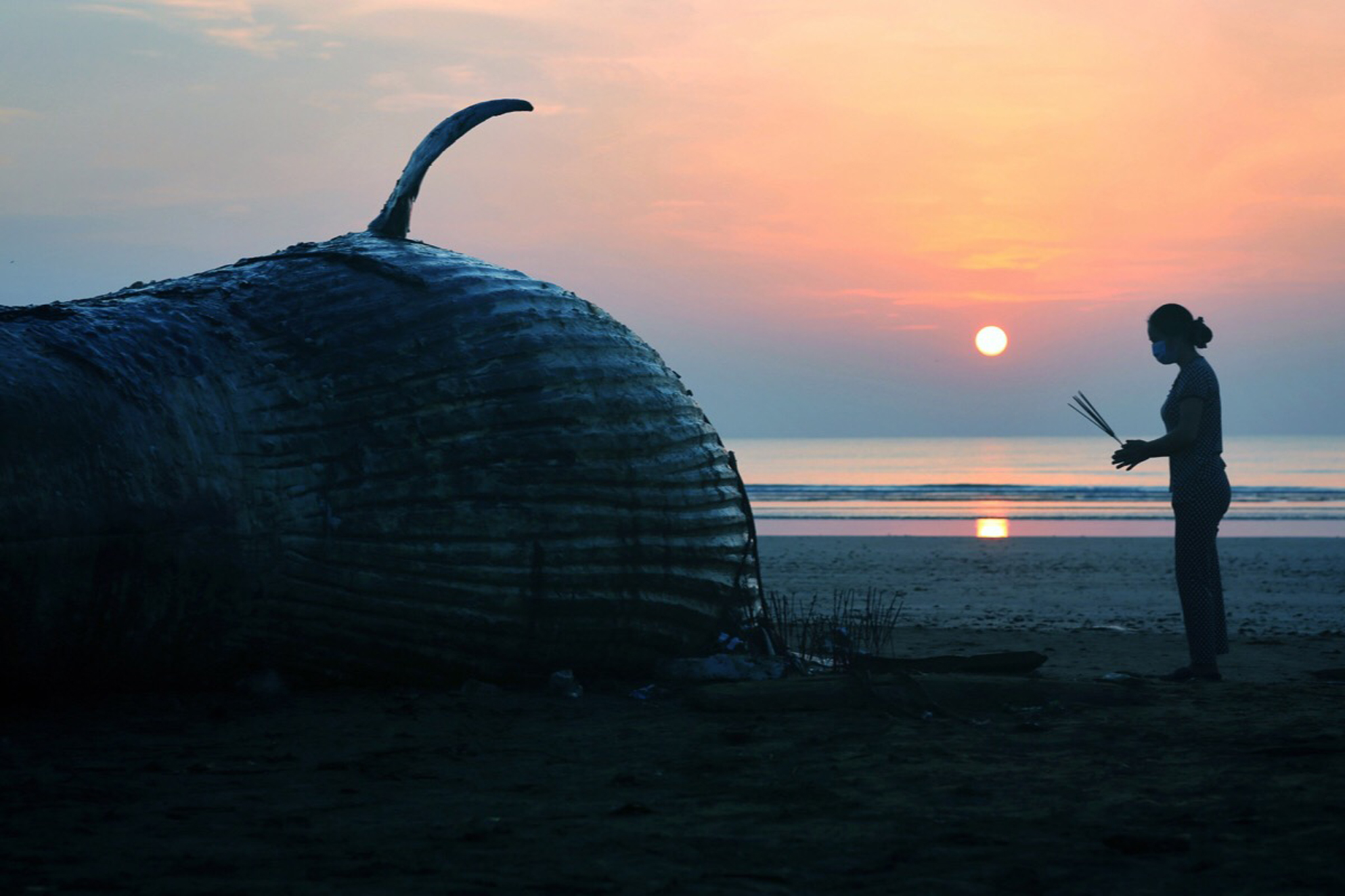
A prayer for Whale's soul. Photo by Nguyen Viet Thanh from the contest "Our Ocean, One Future".[9]
- In human cultures, the sea appears in contradictory forms, sometimes fierce, sometimes peaceful, both benevolent and dangerous. The sea occupies a undeniable place in literature, art, poetry, cinema, theater, classical music, etc.


